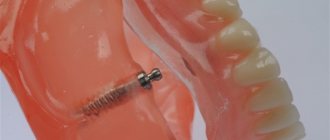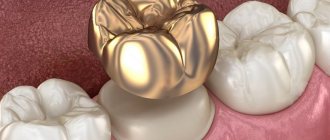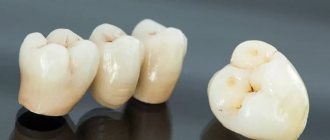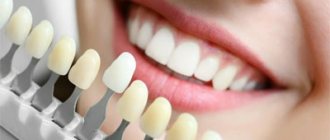Although orthopedics as a science was formed not so long ago, people have been practicing dental prosthetics since ancient times. Animal bones, semi-precious stones, hard wood - everything that ancient doctors did not use as prosthetic material. But the methods of fastening were quite monotonous - using gold, less often silver, wire.
What are dentures made of now? The composition for prosthetics is selected for a specific clinical case, taking into account the patient’s wishes, indications and contraindications.
Content
- Composite
- Ceramics. Metal ceramics
- Ceramic dentures
- Metal alloys
- Plastic
Modern materials for prosthetics help facilitate this process. Today, dentures are high quality structures that are barely distinguishable from real teeth and are comfortable to wear. They are made from various materials.
Modern prostheses:
- High quality;
- Wearable, with a long service life;
- Aesthetic;
- Ensuring the full functioning of the dental system.
Each of the materials from which dentures are made has its own characteristics.
This group includes:
- Ceramics;
- Metal ceramics;
- Plastic;
- Composites;
- Metal alloys.
The choice of the optimal option is carried out taking into account many factors.
PROMOTION
All-on-4 prosthetics turnkey!
120,000 rub.
What are dentures?
These are unique structures used in dentistry that replace a person’s own teeth. They come in two types: removable and non-removable. The name “removable” speaks for itself: such dentures are removed from the mouth to clean and remove food debris. This is quite convenient, but at the same time, this property can also be considered a disadvantage, because for some, the need to clean the prosthesis every day can be tedious. Therefore, many people resort to permanent dentures. These include:
- Veneers are used mostly to correct aesthetic imperfections of teeth.
- Crowns placed on a tooth to prevent further decay.
- Bridges are several interconnected crowns that are installed when two or more teeth are missing.
Teeth perform a number of very important tasks. In addition to the obvious chewing function, without which people would not be able to chew food as necessary for its normal digestion and smooth functioning of the digestive system, they perform an aesthetic function. A person feels much more confident in communicating with others, having healthy teeth and a beautiful, attractive smile. Therefore, if you have any problems with your teeth, you should not delay treatment. Properly selected dentures can help restore an attractive smile.
What should we do to find a prosthesis that would fully meet our requirements and be comfortable and safe? First of all, you need to know what materials quality products are made from.
Composite
The composite is durable and has a long service life. Its only drawback is the high price. But if you need a prosthesis for life, it makes sense to resolve the issue in favor of this composition. Composite is a polymer with many additives that provide exceptional strength and make artificial teeth look like real teeth.
Prosthetics are carried out according to the following algorithm:
- A polymer composition is applied to the prepared area in layers, giving it the shape of a lost tooth;
- Each layer is dried with a special lamp.
As a result of this build-up, the tooth becomes stronger and regains its lost shape. The doctor may use a pin to strengthen the structure. The pin is installed into the remains of the tooth or directly into the root canal.
Metal crowns
These crowns can be called the best for prosthetics of chewing teeth only in terms of price: it will be the lowest, and then only if the crown is made of an alloy of ordinary metals. If the crown is made of gold, its price will be equal to the cost of products made of ceramics and zirconium.
Metal crowns are durable and this quality can also be attributed to the advantages of this option, but there are still more disadvantages to prosthetics with metal crowns. Patients are often allergic to metal crowns; they can cause a galvanic effect, in which a person constantly feels the taste of metal in the mouth. To install metal crowns, you have to remove a fairly large amount of tissue from the tooth being ground, and this is bad, because the more a tooth is ground, the more fragile it becomes.
Installation of metal crowns can cause increased abrasion of antagonist teeth and, of course, metal crowns have poor aesthetics. Such a prosthesis is always clearly visible in the mouth. Aesthetics is not a determining factor when it comes to prosthetics for back teeth, but if you want the crown on a chewing tooth to not stand out from the background of other teeth, it is better to initially consider options for crowns made from other materials. Since metal crowns have much more disadvantages than advantages, we cannot call them the best, and we do not offer them to patients of our dental clinic in Moscow - “Aesthetica”.
Ceramics. Metal ceramics
Ceramics for many years was considered the main material for prosthetics, despite the lack of high strength. This delicate material deteriorated over time, and prosthetics had to be started all over again. Modern ceramic and metal-ceramic prostheses have changed - they are reliable and strong.
The advantage of the material is lightness. Teeth made from it are almost not felt in the mouth. Aesthetic indicators are the best. Ceramics are used for both molars and front teeth.
When performed professionally, prosthetic structures are durable, their shade, translucency and shape are indistinguishable from natural teeth. The manufacturing process does not require much time and lengthy preparation. Treatment is carried out relatively quickly. Ceramics are suitable for patients prone to allergic reactions.
General sequence of clinical and laboratory stages of manufacturing artificial crowns
Dental prosthetics
Several specialists take part in their creation:
- Orthopedic dentist (carries out diagnostics, design planning, consultation, preparation of teeth for prosthetics - odontopreparation, taking impressions, quality control of the construction at all stages with correction if necessary, fitting, temporary and permanent fixation, dispensary observation - periodic examinations);
- Dental technician (together with the doctor, plans the future design and carries out its direct production on models (plaster analogues of teeth and jaws, obtained from impressions) in the laboratory, makes adjustments, if any);
- Dental assistant – performs auxiliary manipulations in the oral cavity and office during treatment.
Stage 1:
- Diagnostic – basic (questioning, i.e. medical history, examination) and additional (usually one of the types of x-ray examination) examination methods, drawing up and agreeing on a treatment plan, impressions for diagnostic models and temporary crowns , preliminary determination of color, bite registration . If necessary, auxiliary measures are carried out - a complex of professional hygiene (removal of dental plaque), treatment or re-treatment of caries (replacement of old restorations), endodontic (pulp removal, re-treatment of the root canal system) or surgical (lengthening of the clinical, i.e. visible crown with insufficient height). In a difficult clinical situation, total prosthetics, a special device is used - a face bow , which fixes the position of the upper jaw in the space of the skull and makes it possible to transfer it to a device that reproduces the natural movements of the lower jaw - an articulator. A dental photography protocol is also used - registration of images of the patient’s face in front and in profile, dentition in a closed and open state in the anterior and lateral sections. This manipulation helps the technician in choosing the visual characteristics of the future restoration (building a color scheme for the restoration, determining its size and shape).
Stage 2
- Preparatory – odontopreparation – grinding of hard tissues to create the shape of the tooth stump, providing the possibility of applying and subsequent fixation of the structure, as well as ensuring the correct relationship between the edge of the crown and the soft tissues of the gums. During this manipulation on living teeth, water-air cooling in order to prevent overheating of the hard tissues of the tooth. Taking working impressions, final color determination. Fitting, correction (relining) and temporary fixation of temporary crowns.
Stage 3
- Final – delivery of the work (trying on and, if necessary, correction of the structure, agreement with the patient on the coincidence of the existing and desired results regarding color, shape, size, convenience, temporary (for combined) or permanent (for metal-free structures) fixation; subsequent replacement of the temporary fixation with a permanent one) .
Metal alloys
As a rule, it is a compound of chromium, nickel and cobalt. The advantage of such materials is their increased resistance to mechanical stress.
Disadvantage: high allergenicity. In patients prone to allergic manifestations, adverse reactions occur frequently.
The preferred material is an alloy of platinum, palladium and gold. The prosthesis from it will be:
- Expensive, but safe and durable.
- Be comfortable and give a feeling of naturalness;
- With a ceramic coating, it will completely match the appearance of natural teeth.
Titanium is a popular and most modern solution in prosthetics.
Titanium prostheses:
- Durable;
- Safe;
- Lungs.
The only drawback is the lack of full compliance with aesthetic requirements. Titanium crowns are placed on the far molars. Here they are not visible to others, but they perform their task flawlessly.
Zirconium oxide remains the traditional choice:
- Lasting;
- Stable;
- Biologically compatible and safe;
- Meeting high aesthetic requirements;
- The color matches the natural enamel of the teeth.
Thanks to laser processing, artificial teeth made of zirconium dioxide completely match the natural shape of the tooth being restored.
What is the best material for prosthetics?
As you can see, the choice of modern materials for dentures is quite large. It is impossible to say definitively which material is better, since each is suitable for a specific purpose. For installing crowns on the front teeth, the best materials for dentures are ceramics, and for molars, metal-ceramics or zirconium oxide are more suitable. A specialist will help you choose which denture material is right for you.
Another important question is what is the compatibility of dentures made of different materials with oral tissues? According to medical research, the most biocompatible bases for artificial teeth are ceramics and zirconium dioxide. Such crowns never cause allergies, this is another big advantage.
Disadvantages of nylon thermoplastics
- Uneven (point) distribution of chewing pressure due to the flexibility of the prosthesis and softening during use;
- Severe uneven atrophy of the alveolar ridge (this worsens the fixation of existing and subsequently manufactured prostheses);
- Absorb liquid and dyes (it is recommended to limit the consumption of strong tea, coffee, sour and hot foods);
- Impossibility of relocation and repair;
- Fairly high cost ;
- Difficulty in complete cleaning at home.
Therefore, their main purpose should be temporary prosthetics (from several weeks to two to three years). The period of adaptation to prostheses, of course, is strictly individual, but on average it is 5–10 days.
How are they attached?
Several fixation methods are used for dentures.
On the closing valve. It is often called a “suction cup”; it is an element of the base, the basis of the structure, which in shape must exactly match the gum. When the denture is placed and bitten, air escapes from the gap between it and the mucous membrane. When completely sealed, a sealed space is formed, and the base is held as if on a suction cup. For more reliable fixation of a complete denture with a closing valve, special gels can be used.
On clasps. This fastening is used for conditionally removable, partial structures; they are mainly made of acrylic. Fixation is performed using metal hooks that are placed on the remaining teeth. Usually these are the incisors in the smile area, and therefore the clasps can be visible. Fixation is reliable, without the risk of displacement or accidental loss, the chewing load is distributed better than when using a locking valve.
On elastic clasps. They are used for structures made of nylon, made of plastic, pink in color, and invisible. Fastening is almost the same as when using metal hooks, but elastic clasps are more convenient, less damaging to the mucous membranes, and easier to get used to.
On attachments. These are composite micro-locks that can be used if the patient has preserved at least part of the dentition. One of the attachment elements is built into the base, the other is fixed to the supporting tooth and covered with a crown. The fixation is reliable, durable, the entire structure is protected from displacement, and transfers the chewing load well. Attachments are used with clasp dentures (having a metal base).











